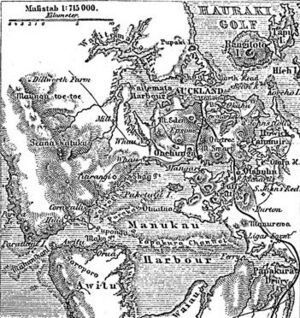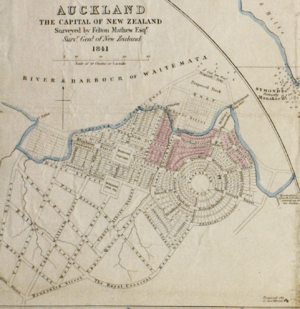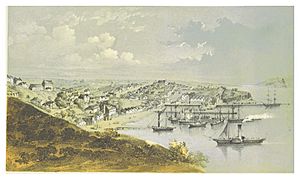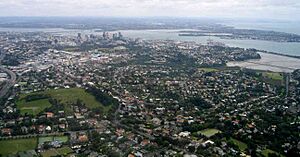History of Auckland facts for kids
The human story of Auckland (also called Tāmaki Makaurau by Māori) began with early Māori settlers in the 1300s. Later, in the late 1700s, the first European explorers arrived. For a short time in the mid-1800s, Auckland was the official capital of New Zealand. Today, it is the fastest-growing and most important city for business in the country.
Contents
Māori History in Auckland
Early Māori Life
Māori people settled the Auckland isthmus around 1350. They called it Tāmaki or Tāmaki Makaurau, which means "Tāmaki desired by many". This name showed how much people wanted this area because of its great natural resources and location. The narrow strip of land was a perfect spot. It had two harbours, giving easy access to the sea on both the west and east sides. The soil was rich, which was great for growing food. Both harbours also provided lots of kai moana (seafood).
Māori built fortified villages called pā on the volcanic hills. These pā had terraces for defense. However, most Māori usually lived in undefended villages called kāinga.
Some of the oldest Māori sites in Auckland are on Motutapu Island and Ponui Island. Early Māori lived by growing root vegetables like kūmara (sweet potato). They also fished and gathered shellfish. Some areas, like Motutapu Island, were special places for making toki (stone tools).
Tribes and Changes
Several Māori tribes lived in the Auckland area. The Ngāi Tai tribe settled in Maraetai. The Te Kawerau ā Maki tribe lived in the Waitākere Ranges. The Ngāti Te Ata tribe was based south of the Manukau Harbour. The Ngāti Pāoa tribe lived along the coast from Whangaparaoa. The main group on the Tāmaki isthmus was Waiohua, a group of tribes.
Between 1600 and 1750, the Tāmaki tribes built many pā on the volcanic cones. They also created huge gardens for growing kūmara. At its busiest in 1750, the area had tens of thousands of people. It was the richest and most populated place in New Zealand before Europeans arrived.
Later, the Ngāti Whātua-o-Kaipara tribe moved south. They took over the isthmus around 1740-1750. They became the main power in the area.
Europeans Arrive
The Ngāti Whātua and Tainui tribes were the main groups living in the area when Europeans first came to New Zealand. Northern tribes like Ngāpuhi got muskets (guns) by trading with Europeans. This led to conflicts known as the Musket Wars.
Apihai Te Kawau, a leader of the Ngāti Whātua tribe, was a friend of missionary Samuel Marsden. He was involved in many battles across the North Island.
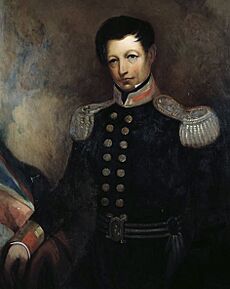
As the Musket Wars ended, the British decided to get involved to bring order. William Hobson was sent to create the Treaty of Waitangi in 1840. On March 20, 1840, Apihai Te Kawau signed the Treaty of Waitangi in the Manukau Harbour area. Ngāti Whātua wanted British protection from other tribes.
Soon after signing, Ngāti Whātua-o-Ōrākei, the main landowners in Auckland, made a special gift. They gave 3,500 acres (1,400 hectares) of land on the Waitemata Harbour to Governor Hobson. This land was for the new capital city.
Over the next 20 years, Ngāti Whātua lost a lot of their land. Some was taken by the government. By the late 1840s, Māori were a smaller group in the Auckland area.
Birth of the City
Becoming the Capital
After the Treaty of Waitangi was signed in 1840, Governor William Hobson needed to choose a capital for the new colony. The main European settlements were in the Bay of Islands and Otago. However, the Bay of Islands was too far away.
Hobson chose the south side of Waitematā Harbour for his capital. This was based on advice from missionary Henry Williams and an offer of land from Ngāti Whātua. Auckland was officially named New Zealand's capital in 1841. The government moved from Russell (in the Bay of Islands) to Auckland in 1842.
Ngāti Whātua likely expected more safety and better trade from the British. The new port would help them trade goods grown in the Waikato and Hauraki Plains with Australian settlements.
Governor Hobson's ship arrived in Auckland Harbour on September 15, 1840. A ceremony to start the new settlement happened on September 18, 1840, at Point Britomart. Hobson named the new place Auckland, after his friend George Eden, the Earl of Auckland.
New settlers from New Zealand and overseas quickly came to the new capital. The first European settlers, William Brown and Logan Campbell, bought Browns Island. They built the city's first house, Acacia Cottage, which you can still see near One Tree Hill.
Early settlers included Catholics, who started Auckland's first school for boys in 1841.

The city's first church, St Paul's, and the Fort Britomart army barracks were built in 1841. Many people, including Māori chiefs, attended the church's founding ceremony. St Paul's served both Māori and European people, with services in both Māori and English. It was the main Anglican church for over 40 years.
The first ships carrying immigrants directly from Britain arrived in 1842. Early on, government officials lived on the eastern side of the settlement. Other settlers, like workers and craftspeople, lived on the western side. This difference can still be seen today, with eastern suburbs often being more expensive.
Protecting the City
Governor George Grey wanted to make sure Auckland would not be attacked. So, the Royal New Zealand Fencible Corps was created. Between 1847 and 1852, many retired British soldiers and their families came to Auckland. They formed a ring of villages around the capital to protect it. These villages included Howick, Panmure, Otahuhu, and Onehunga.
In 1849, Grey also sold land in Māngere to the Māori chief Pōtatau Te Wherowhero. His tribe, Ngāti Mahuta, worked like the British fencibles to help protect the area.
In 1851, a large group of Ngāti Pāoa from Thames arrived in Auckland in many canoes. They were upset about a chief being arrested. British soldiers and fencibles were called out to defend the city. After talks, the Ngāti Pāoa left peacefully.
Losing Capital Status
In 1865, Port Nicholson, now known as Wellington, became the new capital. Wellington was more central, especially as the South Island grew richer from gold discoveries and sheep farming. Parliament first met in Wellington in 1862.
Aucklanders were disappointed to lose the capital status. They started a campaign to redevelop and rebuild the city. Money from goldfields in the Coromandel helped build new public buildings. Auckland remained an important city, especially as a major port and home to the Devonport Naval Base. The opening of the Panama Canal in 1914 made Auckland's port even more important for New Zealand's economy.
City Growth
Auckland was a base for Governor George Grey's actions against the Māori King Movement in the early 1860s. Grey built roads, like the Great South Road, to open up the Waikato region. This helped soldiers and settlers move quickly.
Auckland grew fast, from 1,500 people in 1841 to over 12,000 by 1864. Most growth happened near the port. Auckland slowly became the main business city. Farms were set up on the edges of the city. Logging of kauri trees and digging for kauri gum also helped the area grow.
By 1900, Auckland was the largest city in New Zealand. As the inner city became crowded, people wanted to expand. Trams and ferry services helped the city spread out, especially to what is now North Shore City.
Twentieth Century
New Transport and City Sprawl
In the early 1900s, trams and railway lines helped Auckland grow quickly. But soon, cars became very popular. Auckland had one of the highest rates of car ownership even before World War II. Cars allowed people to live further from the city center. This led to rapid growth spreading across the whole area. In 1959, the new Auckland Harbour Bridge connected the North Shore with the city, helping it grow even more.
During World War II, a Japanese seaplane flew over the city. Coastal defenses were built or made stronger. A large military base on Rangitoto Island stored mines to protect the harbour.
From the late 1930s to the 1950s, many state houses were built. These were usually on large sections of land. Because of this, Auckland became a city with many suburbs.
Important Events
In July 1985, the Greenpeace ship, the Rainbow Warrior, was docked in Auckland. It was getting ready to protest against French nuclear testing. Two explosive devices were placed on the ship's hull. The ship quickly began to sink. The crew got off, but one crew member, Fernando Pereira, died on the sinking ship.
In 1993, a police helicopter and a traffic plane crashed in the air. They fell onto a busy motorway during rush hour. This caused major traffic jams.
In 1998, all four main power cables supplying Auckland's city center failed. This caused a major power outage that lasted five weeks for some areas. Many people who worked in the city had to work from home or from other offices. The power company had to spend a lot of money to fix it and pay businesses.
Another power outage happened in 2006. A faulty powerline caused a short-circuit. This blackout affected large parts of Auckland, including the city center. While it only lasted about half a day, it showed that Auckland's power system could still be easily disrupted.
See also
- Timeline of Auckland history


